An online course is an excellent approach to learning about data structures and algorithms. You may take your skills to the next level with the plethora of internet tools accessible nowadays.
It also allows you to take your time with challenging concepts so that you may learn as much as possible. I provide a collection of the best data structures courses in this article.
I have publicly available and privately developed courses taught by renowned academics and industry leaders. Choose one of these classes if you need to brush up on your programming fundamentals or prepare for an interview that will require knowledge of data structures and algorithms.
1. Data Structures
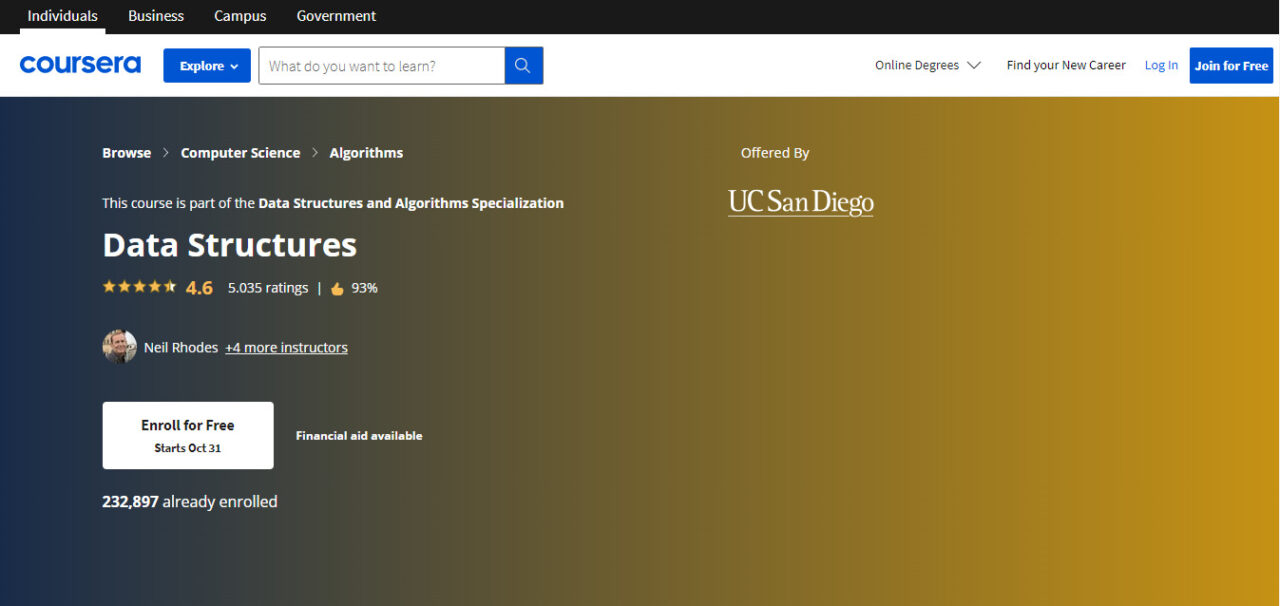
Specifications:
- Difficulty: Intermediate
- Duration: 25 hours
- Price: Free
- Provider: Neil Rhodes
Course’s highlights
This is the second of six required courses that make up the Data Structures and Algorithms Specialization. Coursework in this online offering focuses on the most often encountered data structures and how they apply to various computational issues.
You’ll study the various programming languages’ implementations of these data structures. Then, in our homework, you’ll get some experience using them.
Knowing what to anticipate from a data structure’s internal implementation is much easier when you know how it’s implemented internally. You will also cover regular applications of these data structures.
The course’s introduction to data structures like stacks, queues, hashes, heaps, trees, etc., was fascinating. The movies and slides help explain how an algorithm works and how efficient it is; they provide a great deal of useful information and illustrations.
Each test has high-quality, topic-specific conceptual questions. Achieving success on an assignment is a significant accomplishment, and I remember how proud I was of myself after completing and turning in everyone.
The thing that has surprised me is that teachers still checked in on the discussion boards and answered students’ queries. They were of great assistance.
However, the professor, Daniel Kane, is not very elucidating. I often consulted the works of others cited as references to follow along.
Enroll Here: https://www.coursera.org/learn/data-structures
Pros
- Good material
- A forum for help or share
- Language-agnostic
- The lectors are very good at explanation
Con
- Challenging assignments
2. Data Structures and Algorithms Specialization
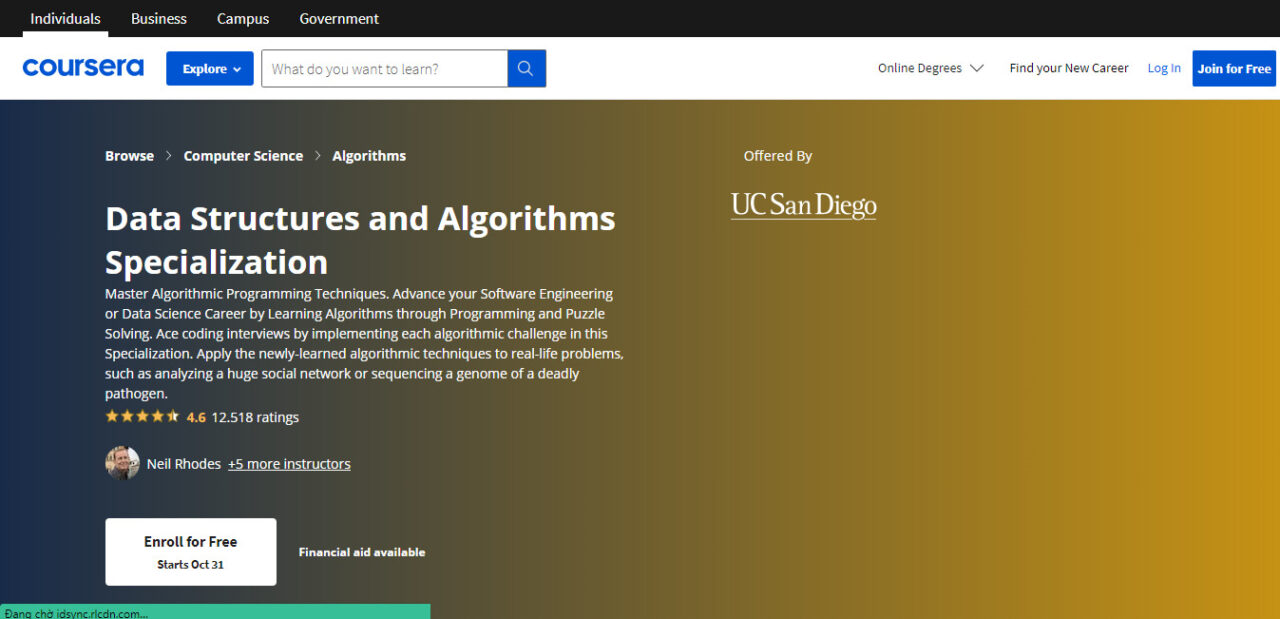
Specifications:
- Difficulty: Intermediate
- Duration: 8 months
- Price: Free
- Provider: Neil Rhodes
Course’s highlights
This curriculum provides a solid foundation in algorithms theory and practical use. It consists of 6 classes that go from the fundamentals of algorithms and complexity to more advanced topics in theory and practice.
A code solution to the assigned problems follows each module’s one to two hours of video lectures and integrated quizzes. The 100 algorithmic coding problems built just for this course are what set it apart for me.
The course uses 15+ test cases to validate your solutions automatically. These help students develop, test, and fix lightning-fast algorithms capable of resolving intractable problems in seconds.
The course’s positive aspects are the automated grading method, the variety of tasks, and the high quality of the mathematical material and the slides.
The often poor accents of the instructors are one of the course’s few drawbacks. Fortunately, better video captioning helped with this issue.
What I love the most is that the course provides you with various options of subtitles, including French, Arabic, Italian, German, Vietnamese, and more.
Enroll Here: https://www.coursera.org/specializations/data-structures-algorithms
Pros
- Automatic grading system
- Diversity of the assignments
- Easy-to-understand explanation
- Quality of the mathematical content and the slides.
- Flexibility to code problems in programming languages
Con
- The bad accent of the teachers
3. Data Structures and Algorithms
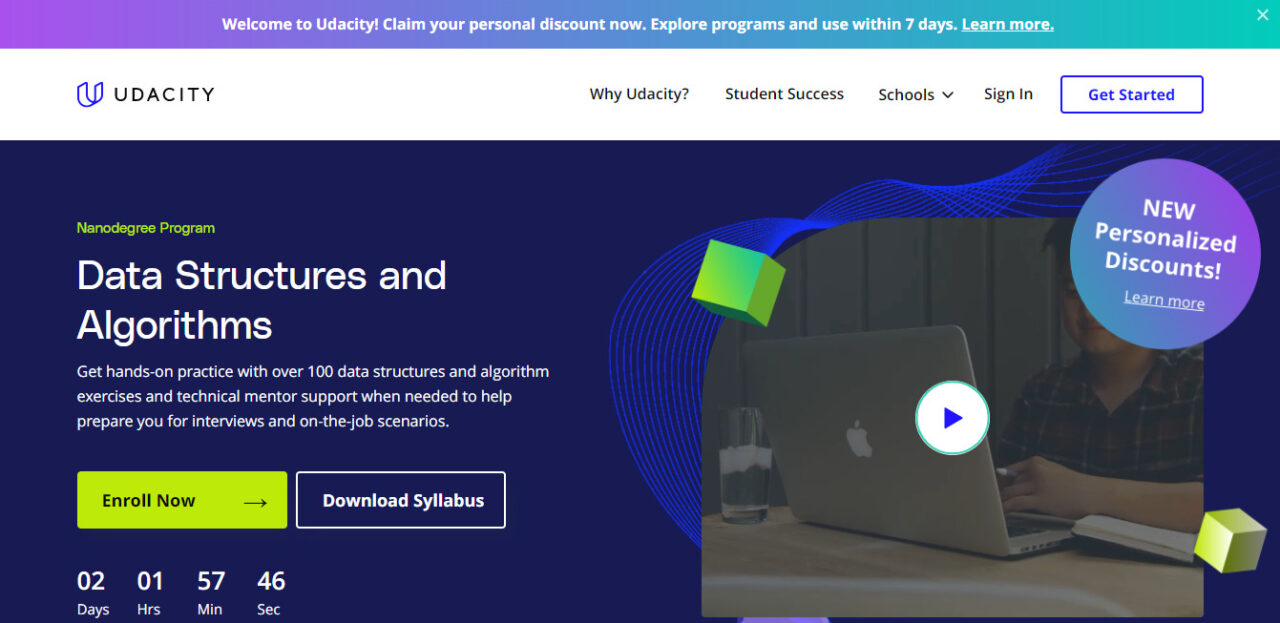
Specifications:
- Difficulty: Intermediate
- Duration: 4 months
- Price: $399 per month
- Provider: Brynn Claypoole
Course’s highlights
This course will teach you data structures and algorithms by having you go through 80+ practice questions. At the beginning of each unit, you’ll go through examples of how to apply the course’s central data structure and algorithm to real-world situations.
After completing each course, you’ll be able to judge the efficacy of various data structures and algorithms for solving a wide range of problems. Based on your design decisions, you may put into action a fix.
Though I have begun to realize the significance of the advice I received, I know it will be invaluable in the long run. The course served its purpose as an introduction to Big O notation, and I look forward to learning more.
It’s helpful to have written materials to accompany the videos since sometimes the instructor conveys the information very quickly on the screen. The accompanying tasks are highly engaging and stimulating despite their brevity.
The recommended implementation is typically really elegant. Therefore I like reading the solution scripts as well. Yet, I wish more problem-solving materials were available, such as further recursion and dynamic programming exercises.
This assignment’s length was commendable for its facilitation of thought about solutions and complexity. One of the best parts was the code review.
With this software’s aid, I could hone my abilities as a data structure designer and an algorithmic efficiency ninja. If I could convince my pals to do anything, it would be to enroll in this Nanodegree program.
Enroll Here: https://www.udacity.com/course/data-structures-and-algorithms-nanodegree–nd256
Pros
- Real-world projects
- Student services
- Student community
- Technical mentor support
- Additional suggested resources to improve
- Project feedback from experienced reviewers
Con
- Lack of practice
4. Data structures and Algorithms Bootcamp
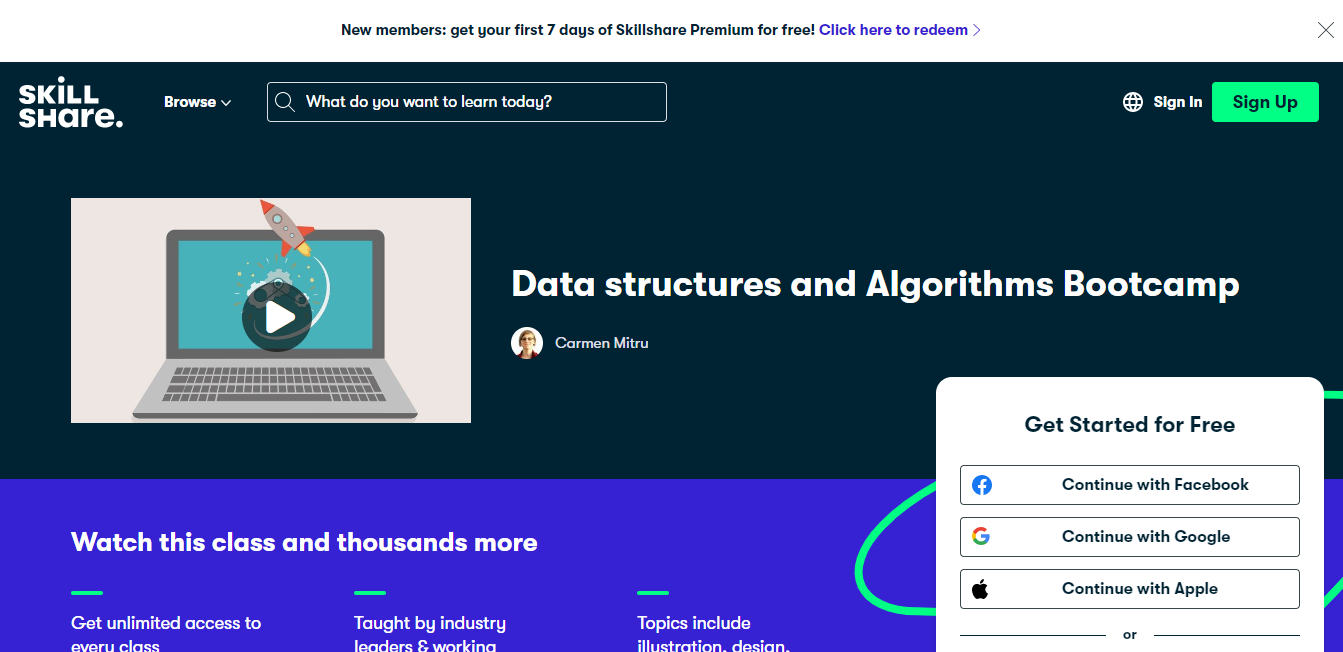
Specifications:
- Difficulty: Beginner
- Duration: 1h 30m
- Price: Free trial
- Provider: Carmen Mitru
Course’s highlights
This course is ideal if you want to brush up on your knowledge of data structures and algorithms or if you need to brush up for an upcoming interview. The fact that it makes no difference whether the programming language you choose is the best part.
You are going to understand how to approach a problem most efficiently. You’ll acquire the skills to develop readable and efficient code, allowing you to interview with any firm.
You will go through 18 lessons in total. The critical parts are Hash tables in Java, Introduction to Stacks, Graphs Introduction, BFS, and DFS. This is an excellent course. Instructors will go through Leetcode challenges.
But it’s best if the instructor doesn’t just dive into examples without first explaining the different kinds of data structures. Using Big O notation to quote complexity without describing it doesn’t express anything; we could not have the fundamental understanding of Big O notation etc.
Several times the level dropped so low I could scarcely hear anything. I cranked up the volume when starting a new video.
Enroll Here: https://www.skillshare.com/en/classes/Data-structures-and-Algorithms-Bootcamp/1438095036
Pros
- Teaching simple coding
- An efficient approach to a problem
- Basic data structures and algorithms
- No programming language knowledge required
Cons
- Sound trouble
- Many complex terms have no explanation
5. Introduction to Data Structures in C++
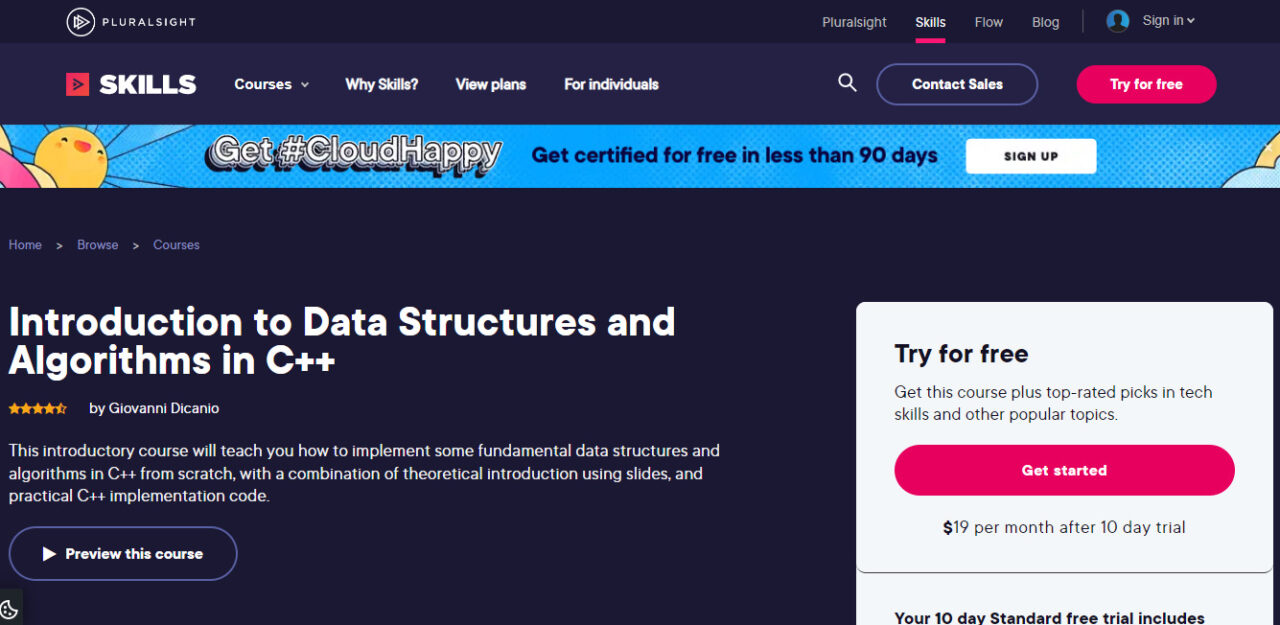
Specifications:
- Difficulty: Intermediate
- Duration: 3h 29m
- Price: Free trial
- Provider: Giovanni Dicanio
Course’s highlights
In this introductory C++ course, you’ll learn the fundamentals of the language and build your implementations of common data structures and algorithms. The course provides you with a theoretical overview presented through slides and working code written in C++.
First, you’ll learn the fundamentals of creating a C++ class that can use arrays securely. After that, you’ll learn how to enhance this array class further by overloading the insertion operator to provide a simple, beautiful, idiomatic printing syntax.
In addition, you will study an array of copying techniques. After that, you’ll learn to use templates to make the array class more generic.
It will then introduce the Big O notation to you practically and intuitively. You’ll get your search skills started with a basic linear search.
At last, you’ll learn about stacks, LIFO, push and pop, and linked lists. What I like most is that there is zero prerequisite expertise in data structures or algorithm theory. If you know the basics of the C++ language, you should be OK.
The course material and the teacher are both excellent. The instructor-created blogs and videos part of the supplementary materials stood out to me.
After completing this course, I now have a firm grasp on the overarching idea that had previously eluded me. I appreciate everything my teacher has done to help me learn how to code and learn.
Adding more complex data structures like heaps, hash tables, forests, and graphs to the curriculum would be fantastic. However, this decent introductory course won’t break the bank if you’re on a tight budget.
Enroll Here: https://www.pluralsight.com/courses/cplusplus-data-structures-algorithms
Pros
- Teaching fundamentals of creating a C++
- Combination of a theoretical overview and working code
- Introducing array copying techniques and Big O notation
- Zero expertise prerequisite with data structures or algorithm theory
Con
- It does not include advanced knowledge
6. Python Data Structures
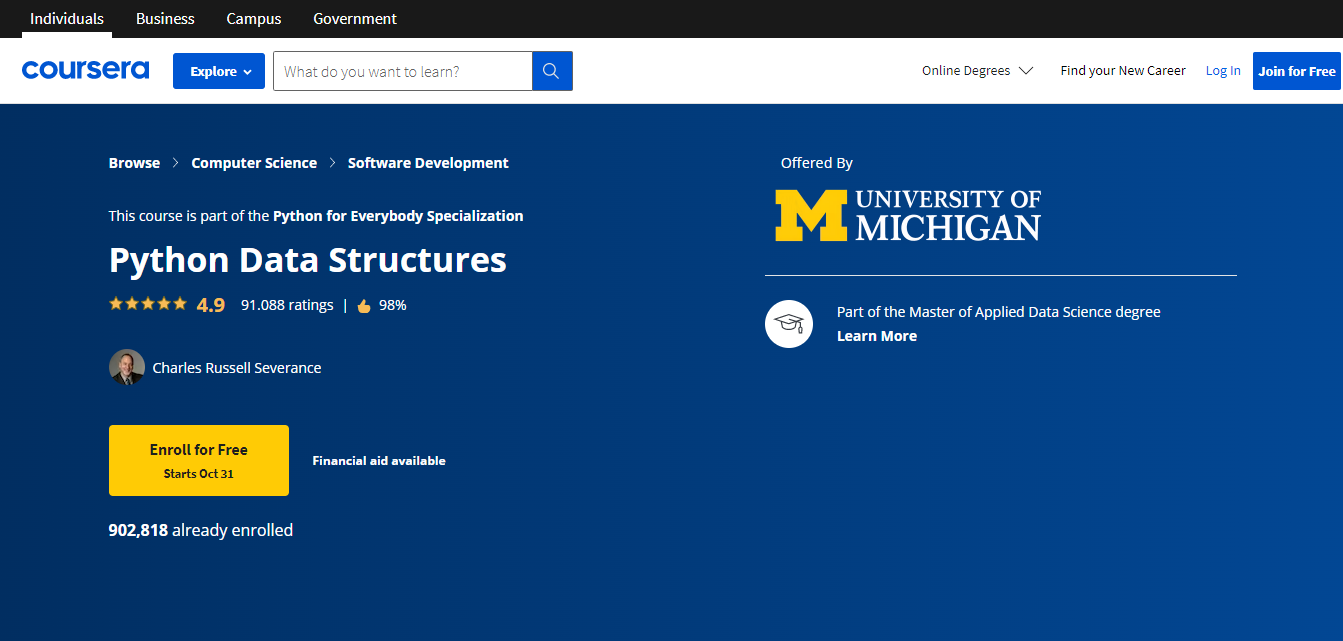
Specifications:
- Difficulty: Beginner
- Duration: 19 hours
- Price: Free
- Provider: Charles Russell Severance
Course’s highlights
Python’s fundamental data structures are the focus of this course. After getting wet with procedural programming, we’ll dive into the advanced features of Python’s in-built data structures.
Previously, I had a minimal understanding of computer programming, and I recall that feeling. Completing the courses, I’m familiar with other, simpler programming languages to use them effectively.
This science consists of seven curriculums. Each curriculum includes videos, reading, and quizzes. It starts with Strings. In this class, we cover Strings and move into data structures.
If you wish to follow the course and run the programs on your computer, you’ll need to install Python during the second week of class. You may get a head start on the course by skipping to Week 3 if you don’t want to install Python.
This class had a lot of laughs! Presented in a warm and inviting style, the information was a breeze to digest.
Unfortunately, I have to tell would-be students that this class relies heavily on material covered in the first class of concentration.
Thus, I recommend this course to anybody who has completed course one and is comfortable with Python’s fundamental syntax.
This is an excellent course for those who are new to programming and want to learn the fundamentals. To keep me interested and involved, I would like additional opportunities to put what I’m learning into practice via frequent quizzes and other in-lecture activities.
Enroll Here: https://www.coursera.org/learn/python-data
Pros
- Weekly practice
- Using Python language
- Inspiring presentation
- Easy-to-understand explanation
- Understandable for beginners
Con:
- Requiring complete the previous course
7. An Introduction to Algorithmics
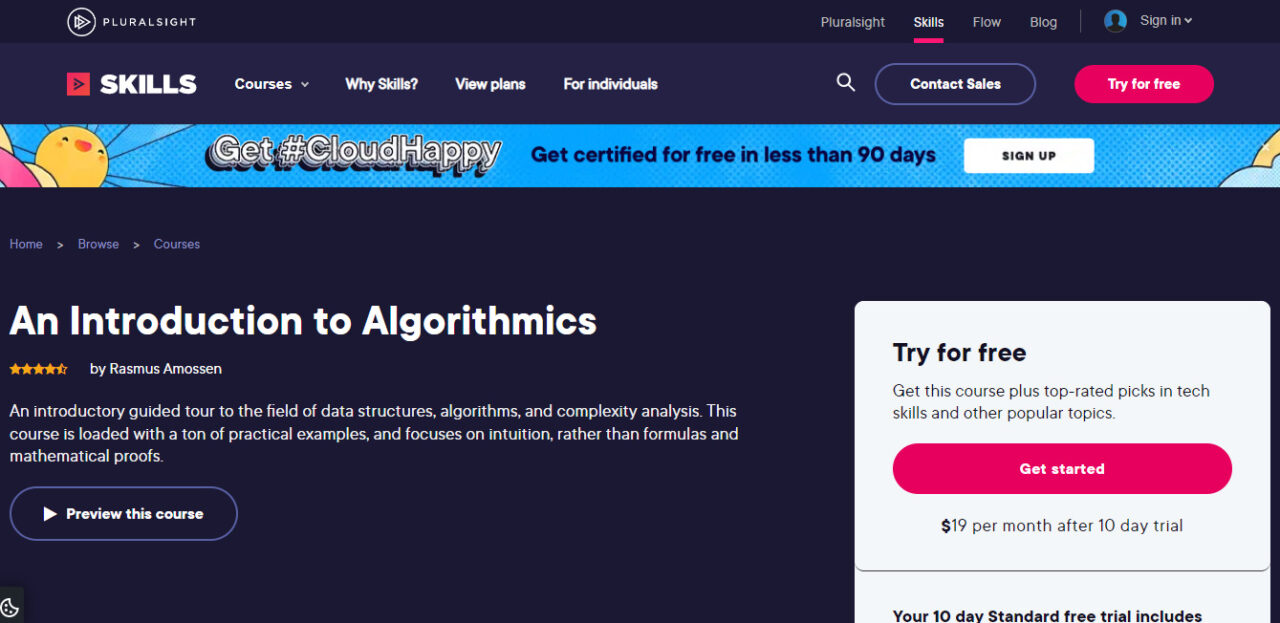
Specifications:
- Difficulty: Intermediate
- Duration: 4 hours 3 minutes
- Price: Free trial
- Provider: Rasmus Amossen
Course’s highlights
This fundamentals course demonstrates how you may use familiar data structures to good use. The instructor introduces the concept of “complexity analysis,” which might reveal an underperforming program, in an approachable manner throughout the course.
When you have a firm grasp of the most fundamental data structures, you may learn more broad algorithms for effectively tackling more complex situations. You may significantly reduce computational time if using the appropriate problem-solving approach.
In the course’s last section, we take a quick look at a few hot topics in theoretical research. It ends up explaining the complexity classes P and NP.
Everyone should take this course since it will teach them much more than just the algorithms covered in the course.
You’ll learn how to think like an algorithmist, build code that dashes and uses as little memory as possible, and solve complex problems.
Mr. Amossen introduces each method and data structure in this course one by one, taking his time to explain and demonstrate how they work using interactive visualizations. The animations are a great aid in explaining the algorithms’ data-processing and problem-solving steps.
The courses have excellent information but are delivered in a rather dull manner. Mr. Amossen can do the job, but he doesn’t precisely captivate an audience.
Anyway, I learned a lot and appreciated the chance to enroll in such a comprehensive algorithm class. I think every severe programmer interested in learning more about algorithms and data structures should read it.
Enroll Here: https://www.pluralsight.com/courses/algorithmics-introduction
Pros
- A ton of practical examples
- Interactive visualizations for explanations
- The instructor speaks slowly and is easy to understand
Con
- Sleepy presentation
8. Learn Complex Data Structures
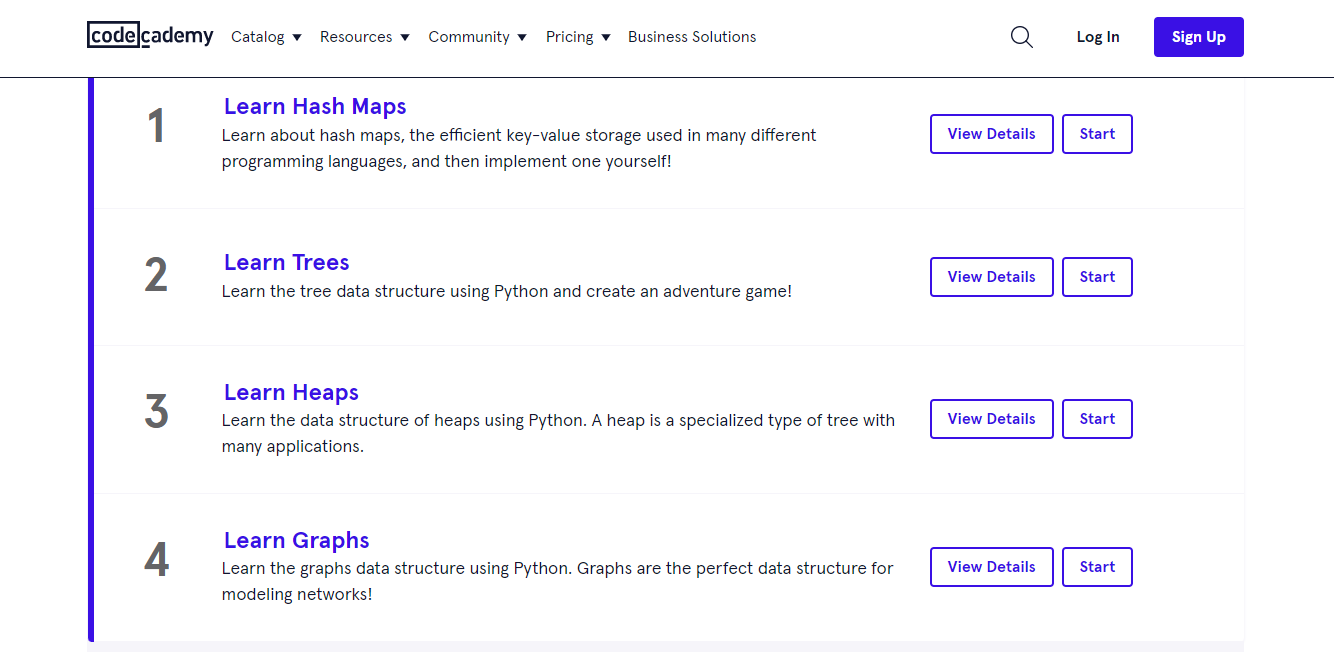
Specifications:
- Difficulty: Intermediate
- Duration: 10 hours
- Price: Free trial
- Provider: Codecademy
Course’s highlights
His course introduces the concepts and practices of abstract data structures. By expanding on traditional data structures like graphs, hash-maps, and heaps, I could learn about and create new ones that adhere to abstract rule-based systems.
I became familiar with hash maps, a kind of efficient key-value storage used across many programming languages, and went on to write my own. This course has prepared me to tackle complex algorithmic challenges, such as route finding and priority queue management.
Many quizzes and tasks are included for further study and application of the material. There are four primary topics covered in the course:
Hash maps: To do this, I studied the efficient key-value storage used by various languages and then built my own.
Tree: It was crucial in learning Python’s tree data structure, which I used to develop an interactive fiction game.
Heap: A heap is a specific kind of tree that you may use for various purposes. Since this is a simple number, I can easily access several numerical examples in this section.
Graphs: Graphs are the optimal structure for representing network topologies. If you can get a handle on it, you’ll have the foundation you need to make all kinds of graphs.
This course will be challenging for those with no prior experience in data science or programming, but the payoff will be huge. It provided me with various teaching tools and practice exercises so that I could apply numerous key concepts of algorithm design and data organization.
This course emphasizes conceptual knowledge and practical solutions, whereas other methods may concentrate on mathematical intricacies and low-level implementation. So, you’ll need programming chops and an understanding of mathematical proof.
The course uses various presentation methods, including video lectures, slides, multiple-choice quizzes, and projects, to determine how well you grasp programming fundamentals.
Yet, because you’ll be using Python to create these data structures, you’ll need to take a course in the language. For newcomers, this might be a stumbling block.
Enroll Here: https://www.codecademy.com/learn/complex-data-structures
Pros
- Presenting information in a sequential flow
- A variety of presentation methods
- Quiz and projects to practice
Con
- Hard to learn for those with no prior experience
9. Data Structures and Algorithms in Swift
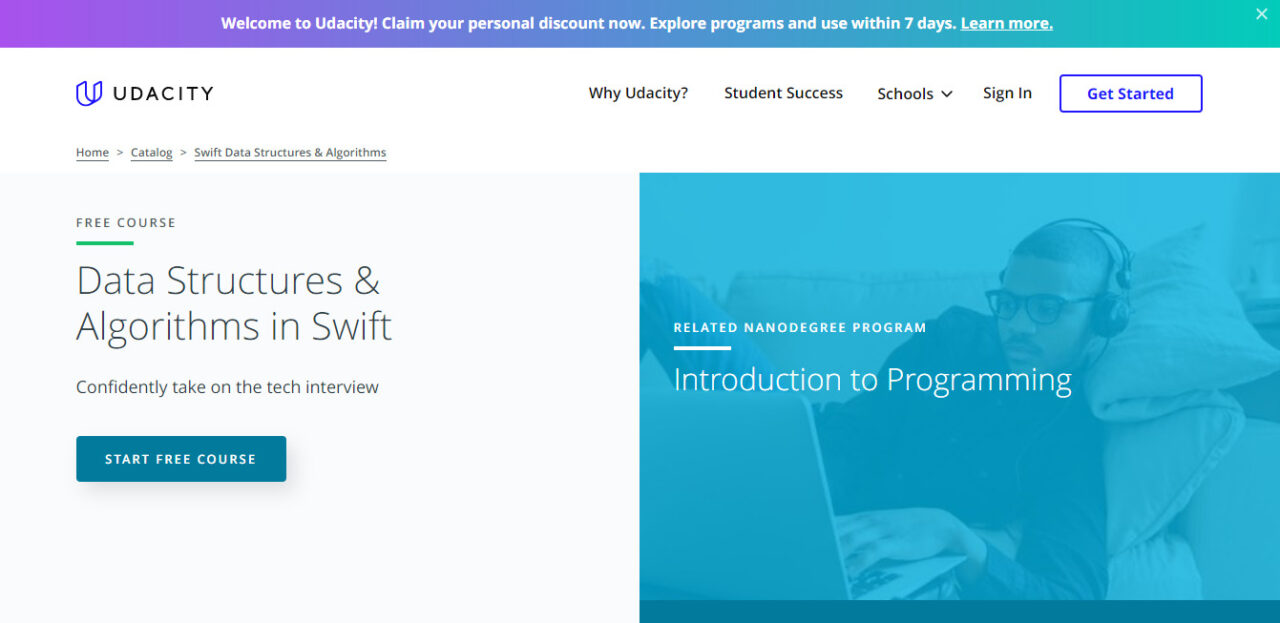
Specifications:
- Difficulty: Intermediate
- Duration: 4 Weeks
- Price: Free
- Provider: Brynn Claypoole and Horatio Thomas
Course’s highlights
This course is for you if you’ve never had formal training in data structures or algorithms. Any engineer needing a grounding in data structures that would like to do it in Swift instead of Python or Java would benefit from this course.
The course’s emphasis on tutorial-style instruction was beneficial to me. For job interviews and to become more comfortable with Pramp, I learned to code in Swift in this class.
Before the lesson, I was given practice problems and tests to gauge my progress. Following this, I do fake interviews to get constructive criticism.
These video guides were beneficial in teaching me the fundamentals. I listened carefully as seasoned engineers went through strategies for any interview.
The instructor covered Common Swift data structures and techniques in this course. I prepared for the technical interview by reviewing typical questions and practicing possible answers.
Before delving into case studies in algorithms, I refreshed my knowledge of tree data structures, hashing, maps, and popular graph concepts.
Each digestible session covers all you need to know to grasp the principles and practical considerations.
Instructors like Brynn Claypoole and Horatio Thomas are invaluable. Their explanations make Algorithms and Data Structures simple enough for me.
If you are having trouble or are interested in learning more about this issue, I strongly suggest you enroll in their course.
However, I think more information and clarification on the methods used would significantly improve this course. Although I had hoped for more details, this free course is a beautiful place to start.
Enroll Here: https://www.udacity.com/course/data-structures-and-algorithms-in-swift–ud1011
Pros
- Instructor videos
- Rich content
- Self-Paced Learning
- Interactive Quizzes and exercises
Con
- Lack of in-depth knowledge
10. Welcome to Python 3

Specifications:
- Difficulty: beginner, intermediate
- Duration: 14 hours
- Price: $149/year
- Provider: Mr. Mashrur
Course’s highlights
This Python programming tutorial is suitable for complete novices and covers all you need to know. As part of my education, I worked on projects that required me to create my algorithms and data structures from scratch.
The course consists of two parts. Part 1 focuses on the Python programming language, while part 2 focuses on Data Structures and larger-scale projects.
What I love the most is the lessons created as animation-heavy instructional videos. The visualizations of programs and algorithms promote my imagination to build it all later.
Even after only one day, I can already attest to how fantastic it is. I feel like I’ve gained an immeasurable amount of knowledge.
My excellent instructor is beneficial in explaining these complex topics. He is fluent in Python and provides very straightforward guidance.
The section on algorithms and data structures was beneficial to me. The lessons are comprehensive, clear, and well-organized.
It is a course I would encourage everyone to take. By a wide measure, this Python course is the greatest I’ve ever taken.
The biggest drawback is that I can’t buy just one course at a time from this site. I have to upgrade to VIP status and access an unlimited number of the best courses available.
Enroll Here: https://courses.stationx.net/p/welcome-to-python-3-project-based-python-algorithms-data-structures
Pros
- A free ebook
- Live help channel
- 14+ hours of animation video
- Providing exercises and quizzes
- 30-day money-back guarantee
Con
- The course is not sold separately.
Learning Guide
Let’s start preparing a strategy to make your study time more productive and enjoyable.
- Keep your eyes peeled for the most helpful tools.
If you want a head start on your education, watching video lectures is a great way to do it.
- Get a firm grasp of the basics.
Having gathered the necessary materials, you should get down to the fundamentals. Master the ins and outs of each data structure and then manually implement them in your chosen language.
- Improve your capacity to identify and address issues
Pick a data structure, tackle 15 simple tasks to get started, and then move on to 10 more challenging problems before tackling at least five really tough ones.
You may solve problems in one fell swoop on some days, but you may be at a loss on others until you begin working on them.
- Partial Duplication
Cramming the codes won’t help you remember them and will cause you to forget all you’ve learned thus far. Practice and spaced repetition are essential to finding a solution to any issue.
After four days, it will be much easier to find a solution. Then, after a week and a month, respectively.
If you practice reviewing the ideas at the recommended intervals, you won’t need as many reviews to retain the information.
- Keep practicing
Getting from a competent level to one of the greatest requires plenty of practice.
If you want to go to the next level, you should try to answer more problems on other websites.
The best method to improve your skills is to compete in coding competitions. They’re like a playing field where you may test your skills and triumph over your rivals.
FAQs
What are the key types of data structures?
- Array
- Stack
- Queue
- Linked List
- Graph
- Trees
Can I learn data structures in 3 months?
The answer lies in the learner. It takes around two to three months to get a handle on the fundamentals of data structures and algorithms, followed by another six months of consistent practice problems.
Why is DSA so hard?
- A failure to constantly educate oneself
- The need to have a wide variety of abilities
- The general misunderstanding of algorithmic processes
- Poor teamwork and inability to clear up confusion
- Uncertain career path
Can I learn DSA without coding?
Understanding the algorithms in terms of Programming will be much simpler after you have a firm grasp on the fundamentals provided by coding. It’s not necessary, however.
Should I do DSA C++ or Python?
Since C++ is so effective for DSA, competitive programmers often use it. It’s a common question to wonder what language is best for data structures and algorithms.
Final Thoughts
Although there is no shortage of data structure and algorithm courses, very few strike the ideal mix between theory and hands-on experience.
This article’s discussed systems provide a balanced introduction to each of these areas of computer science. Data Structures is one of the best courses for beginners. This short course helps you approach the problem most effectively.
In any case, I believe this course has adequately equipped you to decide on your future step. Pick one and begin your journey!
